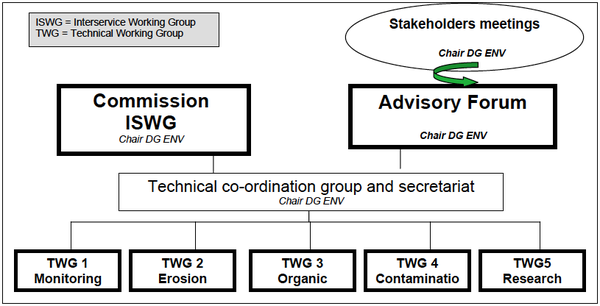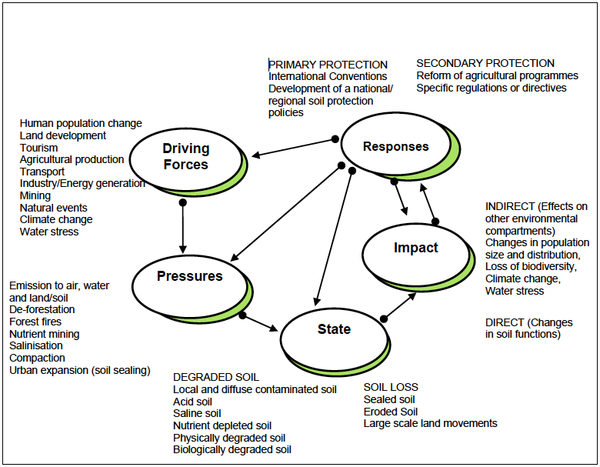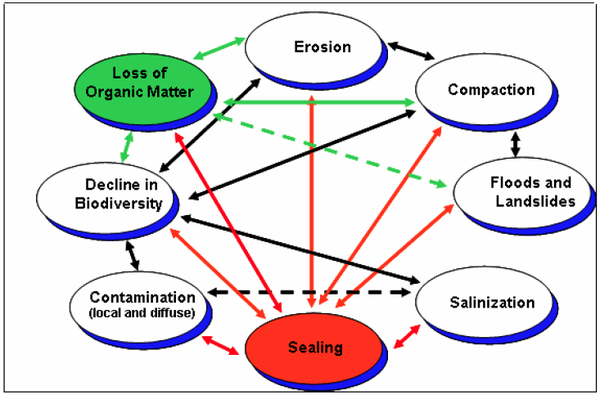SUITMA 2005 Cairo - Urban soils and the European soil thematic strategy
| This abstract is about the plenary presentation by Winfried Blum of the SUITMA 2005 symposium. |
| Winfried Blum.i |
- i - Institute of Soil Research - University of Natural Resources and Applied Life Sciences (BOKU), Vienna, Austria.
Contents
Abstract
Threats to soil caused by urbanization are discussed on the basis of the European Thematic Strategy for Soil Protection, and new research concepts are shown, based on the DPSIR framework approach. From this, it can be concluded that urbanization causes not only sealing, but also other forms of soil deterioration, which can only be understood and controlled by interdisciplinary and multidisciplinary scientific co-operation.
Introduction
Soil is one of the most important ecosystems and largely non-renewable. It is a natural resource and performs six key environmental, social and economic functions. Biomass production in agriculture and forestry depend on soil for the supply of water and nutrients and for root fixation. Soils perform storage, filtering, buffering and transformation functions, thus playing a central role in the protection of water and the food chain and the exchange of gases with the atmosphere. Moreover, soil is a biological habitat, a gene pool an element of the landscape and a cultural heritage, as well as a provider of raw materials. Finally, soils are the physical basis for the development of technical infrastructure, such as housing, industrial production, transport, the dumping of refuse, sporting grounds and others.
Growing population and increasing energy consumption, transport and agricultural activities, linked to pressures such as global climate variability and warming, are adding increasing pressure on the available natural resources in general and especially on the soil environment (Blum, 1988).
Urban soils and the EU soil thematic strategy
The most important threats to soil are described in the EU communication "Towards a Thematic Strategy for Soil Protection" (COM, 2002). Through sealing alone, Europe loses thousands of km² of fertile land every year. A comparison between Europe's natural resources and Europe's built environment reveals clearly that urbanization in a first approach means sealing, or in other words, a total or partial loss of all other functions and uses of soil. This process is developing exponentially.
In many parts of the world, especially in Asia and South and Central America, sealing is impeding biomass production, filtering, buffering and transformation processes as well as the function of soil as a biological habitat and a gene reserve. Moreover, the function of soil to protect and to conceal palaeontological and archaeological remnants as a geogenic and cultural heritage cannot be maintained, and for the process of soil sealing, raw materials, such as gravel, sand, clay and others are extracted.
Looking in more detail into the sealing process, reveals that landscapes and soils are not only covered by settlements and roads, but they are also receiving heavy loads from these sealed surfaces on the adjacent agricultural and forest soils, indicating that for urbanization and related human activities, mining products from inert positions of the inner part of the earth are used and distributed at the earth surface by traffic, industry, settlements and others, contaminating terrestrial and aquatic ecosystems on the atmospheric pathway, the waterway and through terrestrial transport, contaminating these systems by increasing loads of organic and inorganic compounds, which were never existent in these environments. This process is still going on, without any reduction at the moment. Many examples for these processes were published (Blum, 1998; and Pfeiffer et al., 1988) underlining that urban agglomerations are at the same time accumulating any kind of materials, because many people live on a very limited space together, using large amounts of products and creating exhausts and refuse, which can be quite dangerous for urban soils and those in the adjacent environment.
This means that urbanization causes not only loss of soil multifunctionality, but also contamination (local and diffuse), compaction, decline in soil biodiversity, decline in soil organic matter, salinization, erosion, and, under certain conditions, and floods and landslides.
Due to this, urbanization is one of the main threats to the soil environment in the context of the European Thematic Strategy for Soil Protection, because it concentrates on a limited space all 8 threats listed in the EU Soil Communication (2002), hampering and putting into danger the five main soil functions communicated in the same publication. Therefore, the question arises how the European Soil Thematic Strategy and its general goals can be a basis for regulating and controlling urbanization is equal to sealing of soils.
For this purpose, the results of a two year's endeavor, involving five Technical Working Groups (TWGs), with more than 450 participants, mostly scientists, from all over Europe, dealing with soil erosion, decline in organic matter and biodiversity, as well as local and diffuse contamination, are of paramount importance. Moreover, TWGs were formed for monitoring issues and for research, see Fig. 1.
In the context of urbanization, the primary interest is the outcome of the TWG Research, which developed new concepts for soil research within the Thematic Strategy for Soil Protection. The Research TWG had three mandates: a core specific mandate, dealing with research, and two additional mandates, one for sealing issues and one for cross-cutting issues (Van-Camp et al., 2004).
Fig. 1. Organizational set-up of the European soil thematic strategy
New research concepts
The results of the Research TWG, were elaborated on the basis of the DPSIR-approach (Fig. 2), distinguishing between driving forces (D), which develop pressures (P), resulting in a state (S), which by itself creates impacts (I) and for which responses (R) are needed. E.g. a driving force (D) can be a demand for more space for industrial production, lodging, transport facilities, sports and recreation facilities, dumping of refuse and others. The pressure (P) deriving from this demand is urbanization in a broad sense, which means the construction of new industrial premises, houses, transport ways, e.g. roads or streets, parking lots and others. The state (S), created through this pressure is sealed soil, which means considerable losses of agricultural and forest land. The direct impact (I) is less agricultural and forest biomass production, less rainwater infiltration, less biodiversity, and additionally problems of contamination (local and diffuse), compaction, decline in soil biodiversity, decline in soil organic matter, salinization, erosion, and in specific cases also floods and landslides. An indirect impact might be that farmers have to give up because there is no land available for agricultural and forest production. Moreover, these farmers might move into other areas, causing social and economic problems there.
Fig. 2. DPSIR framework applied to soil
The responses (R) should, whenever possible, be directed at the driving forces (D), e.g. through satisfying the demand for new urban structures by other means than sealing new land (e.g. by recycling brown fields, e.g. formerly industrially used sites, Responses (R) can be e.g. social or economic measures, incentives, or legal regulations, in order to reduce urban sprawl.
Therefore, the DPSIR framework allows for key questions to be answered in the understanding of complex soil environmental systems, such as:
- What is the driving force (D) behind the problem?
- What are the pressures (Ps) deriving from the driving forces?
- What is the state (S) which the pressure (P) creates?
- What are the impacts (Is) that result from the state (S)?
- It also allows for responses (Rs), so as to change the driving forces (Ds) in order to alleviate or reverse a problem, developing solutions through the implementation of operational measures.
Based on this approach, new concepts for research were developed by the Research TWG, to deal with identifying and structuring the existing information; identifying barriers that prevent the full use of existing results for policies and recommendations and how to improve the transfer of information; identifying research gaps, with indications of the times within which these can be closed (short-, medium- and long-term) as given by Van-Camp et al. (2004). This task was accomplished by developing a concept for integrated research in ecology, as exemplified by soil (see Tab. 1).
Table 1. Concept for Integrated Research in Ecology – example soil (W. E. H. Blum and J. Büsing, 2004)
| MAIN RESEARCH GOALS | RESEARCH CLUSTERS (see Fig. enclosed) |
SCIENCES INVOLVED | |
|---|---|---|---|
| 1 | To understand the main processes in the eco-subsystem soil induced by threats | Analysis of processes related to the 8 threats to soil and their interdependency: erosion, loss of organic matter, contamination, dealing, compaction, decline in biodiversity, salinisation, floods and landslides | Inter-disciplinary research through co-operation of soil physics, soil chemistry, soil mineralogy and soil biology |
| 2 | To know where these processes occur and how they develop with time | Development and harmonisation of methods for the analysis of the State (S) of the 8 threats to soil and their changes with time = soil monitoring in Europe | Multi-disciplinary research through co-operation of soil sciences with :
|
| 3 | To know the driving forces and pressures behind these processes, as related to cultural, social, economic, ecological or technical, local, regional or global developments | Relating the 8 threats to Drinving forces (D) and Pressures (P) = cross linking with EU and other policies (agriculture, transport, energy, environment etc.) | Multi-disciplinary research through co-operation of soil sciences with political sciences, social sciences, economic sciences, legistic sciences, historical sciences, philosophical sciences and others |
| 4 | To know the impacts on the eco-services provided by the sub-system soil to other environmental compartments (eco-subsystems) | Analysis of the Impacts (I) of the 8 threats, relating them to soil eco-services for other environmental compartments: air, water (open and ground water), biomass production, human health, biodiversity | Multi-disciplinary research through co-operation of soil sciences with geological sciences, biological sciences, toxicological sciences, hydrological sciences, physio-geographical sciences, sedimentological sciences and others |
| 5 | To have operational tools (technologies) at one's disposal for the mitigation of threats and impacts | Development of operational procedures for the mitigation of the threats = Responses (R) | Multi-disciplinary research through co-operation of natural sciences with engineering sciences, technical sciences, physical sciences, mathematical sciences and others |
From this table, the main research goals can be identified, as can the research clusters, needed to reach these goals and the sciences which have to be involved, Blum et al. 2004. The five research clusters are shown in more detail in Fig. 3, from which it becomes clear that it is necessary to: (1) analyze the processes related to the 8 threats to soil and their interdependency; and subsequently; (2) develop harmonized and standardized methods for the analysis of the state of the 8 threats to soil and their changes over time (i.e. soil monitoring); (3) eight threats can be related to the driving forces and pressures, cross-linking them with cultural, social and economic drivers, such as EU and other policies (e.g. agriculture, transport, energy, environment and others), as well as technical and ecological drivers (e.g. global and climate change); (4) an analysis of the impacts of threats can be achieved, relating them to the soil eco-services for other environmental compartments, such as air, water (open and ground water), biomass production, human health, biodiversity and culture; (5) develop strategies and operational procedures to mitigate the threats; this means that responses can be given to alleviate the problems. The functional interdependencies between the eight threats are shown in Fig. 4.
The ecological, technical, economic, and social drivers of the soil threats are linked to EU and other policies. Thus, it can be said that urbanization means impairment of goods and services, such as air, water, plant cover, biodiversity, human health and culture.
Fig. 3. The five main research clusters based on DPSIR
With the definition of priority research areas for soil protection against urbanization and peri-urbanization within the EU Thematic Strategy for Soil Protection, short-, medium- and long-term activities could be distinguished. Moreover, comprehensive research projects on the basis of single research proposals were formulated, bringing different sciences together (cf. the right side of Table 1). It will now be necessary to rank those comprehensive research concepts in order of urgency in such a way that they can be put into practice by institutions in the European Union and other regions of the world. With the new research concept not only the soil processes induced by threats and their changes with time can be analyzed but also the drivers and the processes behind them as well as the impacts caused by losses of soil ecoservices, thus facilitating the development of strategic and operational procedures to control urbanization. This can only be achieved by interdisciplinary co-operation within soil sciences and multidisciplinary co-operation with other natural, technical, economic, social, logistic and cultural sciences.
Fig. 4: Threats to soil and their functional interdependencies
References
- Blum, W.E.H., 2002. Environmental protection through sustainable soil management, a holistic approach. In sustainable land management – environmental protection, a soil physical approach. M. Pagliai and R. Jones (eds.). Advan. Geoecol. 35: 1-8.
- Blum, W.E.H. 1998. Soil degradation caused by industrialization and urbanization. In. Towards sustainable land use. H. P. Blume, H. Eger, E. Fleischhauer, A. Hebel, C. Reij, K.G. Steiner (eds.), Advan. Geoecol. 31: 755-766..
- Blum, W.E.H., 1988: Problems of soil conservation. Nature and Environment Series No. 39, Strasbourg.
- Blum, W.E.H., J. Büsing, and L. Montanarella, 2004. Research needs in support of the European thematic strategy for soil protection. Trends in Analytical Chemistry. 23: 680-685.
- Pfeiffer, E.M., J. Freytag, H..W.Scharpenseel, G. Miehlich, and V. Vicente. 1988. Trace elements and heavy metals in soils and plants of the southeast Asian Metropolis Metro Manila and of some rice cultivation provinces in Luzon, Philippines. Hamburger Bodenkundl. Arbeiten, Bd.11.
- Van-camp, L., B. Bujarrabal, A.R. Gentile, R.J.A Jones, L. Montanarella, C. Olazabal, S. and K. Selvaradjou (eds.). 2004: Reports of the Technical Working Groups established under the Thematic Strategy for Soil Protection. Volume VI: Research, Sealing and Cross-cutting issues. EUR 21319 EN/6, Office for Official Publications of the European Communities, Luxembourg, P. 719-872.




